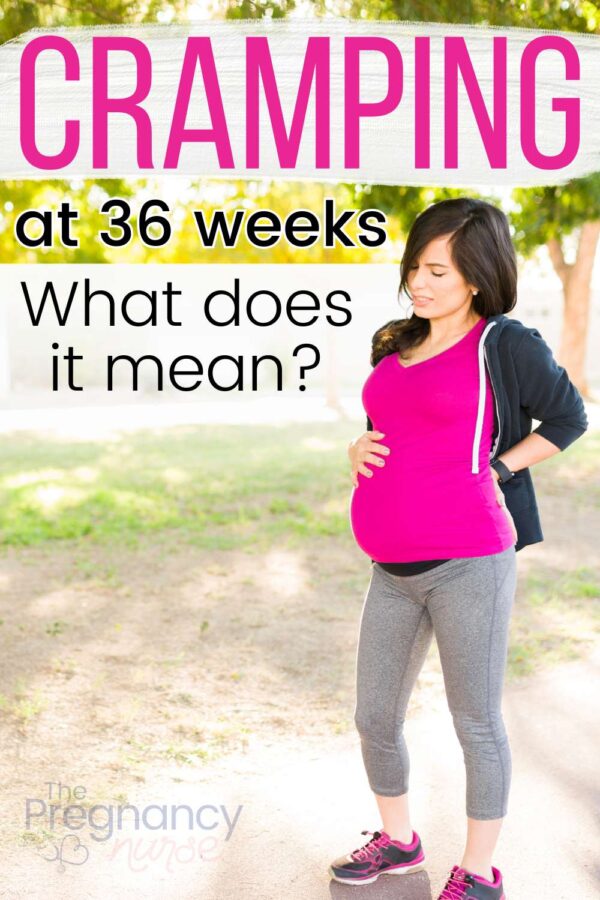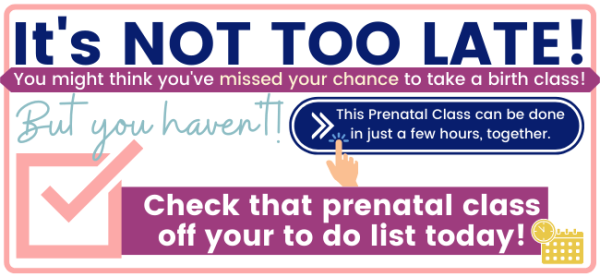📣 YOU are clearly getting prepared for pregnancy, birth & beyond — but do you wish your partner was more involved (looking for a teammate rather than just a cheerleader)? Couples love THIS! 💛🧡💚
Are you 36 weeks pregnant and experiencing period-like pains and backache? Congratulations – you’re in the home stretch! This article will help to explain what might be causing your symptoms, and offers some tips for finding relief. Take a deep breath and relax; you’re almost there!
Big note: Period pains at 36 weeks are VERY different then period pains at 32 weeks — so be VERY mindful of how far along you are and what it could mean for your baby. Please talk with your provider about your needs and specific circumstances, this article is only informational and should not be taken as medical advice.
Oh, and if you’re 36+ weeks, I have some BIG advice for you — so, stay tuned!

Whew, now that we’ve gotten that out of the way — let’s talk about those 36 week pains!
What is causing period pains and backache?
There are a few different things that might be causing your period-like pains and backache at 36 weeks pregnant. You might be experiencing round ligament pain, labor contractions, back labor or dehydration. Read on to learn more about each of these potential causes and how to find relief.
These CAN be signs of early labour, but most often at 36 weeks it is pain that comes and goes. Something to just keep an eye on, and maybe pack your hospital bag. The early stages of labor can be really confusing.
Round ligament pain: Round ligament pain is a sharp pain, sometimes described more as “shooting” that comes on suddenly and is caused by the round ligaments stretching to accommodate your growing uterus. This type of pain is normal and nothing to worry about; however, it can be quite uncomfortable. I find it comes more frequently with sneezing or standing up quickly. To ease round ligament pain, try lying down on your side (be sure to tuck a pillow under your belly, and possibly a pillow between your legs too) taking a warm bath, or using a microwavable heat pack.
Pelvic Fullness: Many pregnant women describe baby’s head being lower as a “pelvic fullness” which can be similar to period pains. It is just the baby’s head creating pelvic pressure. This can also cause a lower abdomen dull ache that may be uncomfortable (and similar to period issues).
Labor contractions: Labor contractions are the body’s way of getting ready for childbirth. They are usually regular and become more frequent, intense and longer-lasting as labor progresses. Braxton Hicks contractions are also a type of labor contraction; however, they are usually irregular and not as intense as true labor contractions. If you’re not sure whether or not your contractions are Braxton Hicks or the real deal, give your healthcare provider a call. I have a whole post on false labor on my sister site.
Pro Tip: ALL contractions can be painful (although some may feel more as a “tightening”, but not all are opening your cervix. You’ll have quite a few contractions that don’t do much at all as far as a number for how dilated your cervix is. That doesn’t mean they’re not doing anything, it’s just more “behind the scenes”. They are “real contractions” it just depends on what they’re doing for you or your baby, or your body.
Back labor: Back labor is a type of labor pain that is felt in the lower back. It is caused by the baby’s head pressing against the mother’s spine/ lower back.
Back labor can be quite intense and is often described as a dull, deep ache. To ease back labor pain, try lying down on your side or sitting on a birth ball, or using a hot water bottle. This may just be the baby’s positioning with their head hitting you back and causing lower back pain as well (may not be labor).
Once you’re in labor and baby’s head descends into the birth canal (and hopefully baby rotates) this pain will shift and you’ll experience it in different places. Baby’s position can really change how you feel labor.
Dehydration: Dehydration can cause cramps and backache. Be sure to drink plenty of fluids throughout the day to stay hydrated. Try to avoid caffeine and alcohol, as they can actually contribute to dehydration.
Baby Moving: While it could be a sign of labor, often this type of pain is from baby moving and growing in your ever-expanding abdomen. You will need to rest more, expect less of yourself and put your feet up more as baby head to the finish line!
If you’re past 36 weeks — my pro tip is to make SURE your prenatal class is both purchased, and DONE (some people seem to think purchasing it is enough).
If right now you’re thinking — Hilary, there is just no way I’m going to get that in. I have great news for you.
The Online Prenatal Class for Couples is the class created with bite-sized birth chunks that you can do in under 20 minutes a few times/day until you’re totally prepared.
That’s right, watch it at meals, while you’re getting ready in the morning — it doesn’t have to be done all at once (and let’s all say a fond farewell to those torturous marathon weekend birth classes)
This is the class for you if you’re:
- Busy — and you’re just not sure how you’re going to fit in one more thing.
- Nervous — if you have any anxiety about birth it’s time to get rid of those pesky birth fears once and for all!
- On a Budget — Finally, a birth class that won’t break the bank. Right now it starts at $89 — but if you buy right now, use coupon code LASTWEEKS to get 10% off!
So, since it’s available 24/7 you can get started right now!

Tips for finding relief from period pains:
There are a few things you can do to find relief from your period-like pains and backache and are 36 weeks or greater:
First, try changing positions. If you’re standing, sit down; if you’re sitting, lie down. My own bump to bassinet class actually includes labor movement cards that will give you ideas on how to move during this time.
Second, try taking a warm bath or using a heating pad on your lower back.
Third, drink plenty of fluids and avoid caffeine and alcohol.
Lastly, if you’re still in pain, call your healthcare provider to see if they can recommend anything else. They may want to see you in the office, and could even check your cervix to see if it’s opening your cervix or just generalized uncomfortable-ness.
Want to know more on ways to manage pregnancy pains — check out these posts:
- 5 Fixes For Groin Pain During Pregnancy
- What Does Round Ligament Pain Feel Like
- How To Sit In An Office Chair During Pregnancy
- Sharp Abdominal Pain During Pregnancy
- Symptoms Of Lightening: Is 35 Weeks To Early?
When should you consult your doctor
If your symptoms are severe, or if they don’t improve with self-care measures, consult your doctor. Also, if you’re experiencing any unusual symptoms, such as vaginal bleeding or contractions that are more than five minutes apart, call your doctor. These could be signs of labor or a problem with the pregnancy, and you’ll want to make sure everything is okay.
If you are wanting something for the pain, I would call your doctor before taking any pain medication, unless they have previously recommended something.
There are other pain relief options like positioning, heat, shower/bath that can help relax you as well.
If you’re 36 weeks, it’s smart to have some of your essentials in a hospital bag too:
Things to keep in mind at 36 weeks of pregnancy?
Is it OK if baby is born at 36 weeks?
Yes, it is generally safe for babies to be born at 36 weeks. However, it’s important to consult with your healthcare provider to discuss any risks or concerns. It may be different depending on how accurate your dates are or any other health conditions.
Remember, your due date is considered plus or minus 2 weeks. Meaning at 36 weeks you could be 38 weeks, but you could also just be 34, and that is a BIG difference for baby.
Thirty-six weeks is earlier than we’d prefer baby be born, but it is not likely that they will have to stay in the neonatal intensive care unit (NICU) at this point -although any baby has that risk due to complications.
37 weeks is the cut-off for when babies are now considered “term” — so it would be considered a “premature” birth (but not unusual — when I started labor and delivery 36 weeks was considered term). Many hospitals call this a “late preterm birth”.
Would they stop me from going into labor at 36 weeks?
Although every practitioner is different, most often at 36 weeks they will not stop you with any medical methods (like medications). While this is premature labour, if your body is going into labor on its own it likely shows baby is ready to come out. And, in many cases labor will stop and will not result in a premature birth if they don’t do something to keep labor going.
Ultimately, they will weigh the risks from the medications vs you having the baby and decide which is best.
They can leave decisions like that up to you, which is why I recommend a class that includes information on communication to get the information you need to make the choices for yourself!
Have you checked a birth class off your to do list✅? I have a few I recommend:
❤️ Best class for couples {per BabyList}
👩💻 Best class available on demand
⚡ Best class JUST for pain management
👶 Best Postpartum-Only Prep
❤️🧡💛💚💙💜 My favorite class is here.
Now is the time to get started!
How likely is it that I am in labor?
There is a good chance that you are in labor if you are experiencing regular, intense contractions that are getting closer together. But, many people have close contractions for an hour or so, and then they dwindle. So, only time will tell.
The thing that separates active labor from early (sometimes “false” if it goes nowhere) is really that it just progresses into labor.
I actually have a quiz about am I in labor you might find helpful.
How will I know if I’m in labor?
These pains will just get more intense until you are more sure that it is labor. If the pain is more constant it is likely not labor.
Regular contractions that don’t go away is the true sign of labor — and how you’ll really know if it’s the “real thing”.
Here are a few signs of labor:
- Losing your mucus plug
- Your amniotic sac breaks
- Changes in vaginal discharge
- Some bleeding (we call this bloody show) — although if it’s enough to fill the surface of a pad you need to call your provider
- Digestive system issues (like nausea or diarrhea)
Don’t miss my super helpful post all about the signs of labor. Great info for pregnancy!
How do I know I’m in “active labour”?
In general, active labor is when you are having contractions 3-5 minutes apart (closer to 3 minutes if it’s your first baby) that last an hour and are too difficult to talk through because of the intense pain. However, every woman is different, and be sure to talk to your health professionals before listening to this advice. It can vary depending on you, your circumstances, risk factors, even how far away the hospital is.
How do I know if my amniotic sac is broken?
Most often you’ll get a gush of fluid, although when some people’s water breaks it just has a trickle of amniotic fluid. With changes in discharge it can be confusing. If it’s not a big gush, I often recommend you wear a pad around for a bit and see if it keeps coming out. If there is any question as to if your water has broken, it is a good idea to contact your health care provider. If it were to go un-noticed there is a risk of infection.
I do have an “is my water broken” quiz that might help you know also.

What can I do to go into labor?
Some of you may be WANTING to go into labor, and it really is up to your body if that happens. However, having your birth partner make you as comfortable as possible and helping you change positions frequently (when not sleeping) can help baby find their best way out.
I talk about the BEST things to do in early labor in Labor Made Easy, but here’s a bigger tip:
Partners can be SO helpful during this stage — this type of thing doesn’t come naturally to most men — so some prep can REALLY help! Which is why I created the best childbirth class for couples!
That being said, there isn’t a whole lot you can do. You will likely have many periods of “false labor” where things are very uncomfortable and then slowly get better before actual labor.
Either way, this is a really exciting time for you and your growing baby. Listening to your body is one the main ways you can stay safe. Make sure that you’re still doing kick counts daily, and it’s likely that I’ll see you well into your 37th week of pregnancy.
It may feel like it’s too late, but it is NOT too late to get a prenatal class in! Especially The Online Prenatal Class for Couples. Not only can it be done in just 3 hours, and that low prices guarantee will get you BOTH prepared in just few hours (it’s gonna feel so good!).
And, if you’re not quite sure you’re ready for that whole thing (or you want to see if we’re a good fit for each other) check out my free prenatal class. It’s your first step toward becoming your own birth boss.






 Pelvic Pain Relief During Pregnancy
Pelvic Pain Relief During Pregnancy
